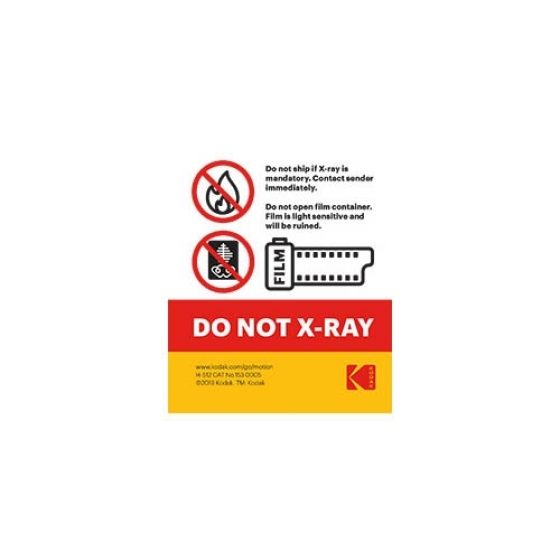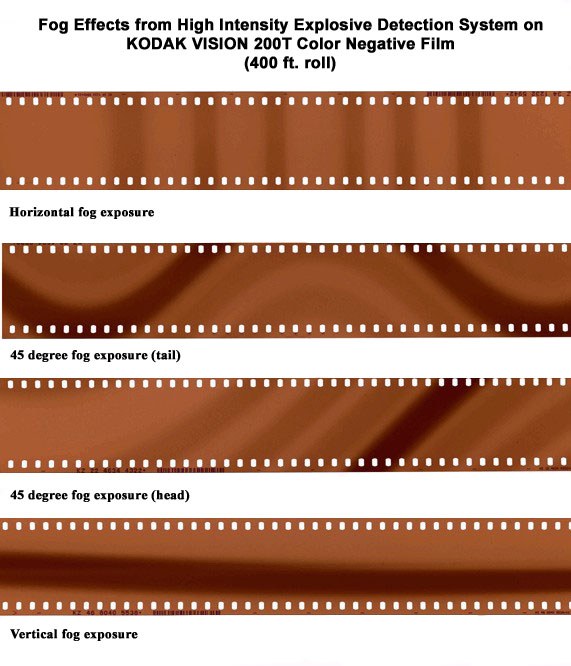Transporting and Storing Film

Downloadable 'DO NOT X-RAY' Labels
Print labels on AVERY 5164 White Laser Shipping Labels (3.33"x4"). For extra protection, place a piece of clear shipping tape "over" the Do Not X-Ray label to protect the ink in case the box is exposed to rain or moisture.
Ground Shipping Film
The safest method of shipping raw or exposed and unprocessed film is GROUND shipping. As with any film shipment, the Carrier should be notified that the shipment contains unprocessed film and should NOT be x-rayed.
Air Shipping Film
The requirement of x-ray scanning can be dependent on:
- Is the Shipper considered a "Known Shipper" to the carrier
- Is the carrier a passenger airline, a freight forwarder, or an integrated carrier
- Is the shipment origin/destination Domestic or International
The recommendation regarding Air shipping of film products is for the shipper to contact the sales office of carriers to discuss their shipping needs including avoidance of x-ray scanning due to risk of damaged. The carrier can then provide the shipper with their requirements and processes. Carriers are aware of the sensitive nature of film shipments and are willing to work with film shippers as long as the carrier is in compliance with the requirements given to them by the Homeland Security Dept and the NTSB. Some air transportation options are:
- Air Express for smaller, lighter shipments - including but not limited to companies like Airborne, FedEx, or UPS
- Air Freight for larger, heavier shipments - including but not limited to companies like BAX Global, Eagle Global Logistics, Excel, or Emery
- Passenger airlines for light or heavier shipments within certain packaging dimensions based on space available at time of shipment.
The air services provided vary from Next Flight Out/Same Day service to Next Morning, Next Afternoon or Second Day services depending on carrier.
More information can be found on the United States Transportation Security Administration web site: U.S. Transportation Security Administration
Airport Security & Motion Picture Film
This document contains advice for motion picture customers who need to transport film by air or via the US Postal Service.
Airport X-Ray Security
Security precautions at US Domestic & International airports have been significantly tightened in recent years. Among precautions that travelers can expect will be the increased use of new, high-intensity x-ray scanners for checked baggage and hand-carried baggage. Passengers should be aware that these high‐intensity scanners will fog and ruin unprocessed film of any speed, whether exposed or not. Kodak recommends that air travelers do not carry unexposed or unprocessed motion picture film. If it is unavoidable that film is carried, passengers should contact the airport in advance to request hand-inspection, allow additional check-in time for such procedures, and follow the advice given below.

Checked Baggage
Any checked baggage may be subject to high-intensity x-ray scanning in a machine that is out of sight of travelers. Airline check-in agents rarely, if ever, warn travelers of this. Never pack unprocessed film in baggage that will be checked.
Hand-carried Baggage
New carry-on baggage scanning equipment is being employed throughout the world. These new CT (Computer Tomography) Scanners using higher intensity energy have been proven to fog all unprocessed film. Travelers should be wary of all scanners in domestic and foreign airports.
Travelers should politely insist on hand-inspection of their film. Carry all film in clear plastic re-sealable bags and carry a changing bag for use by the inspector. Demonstrate how it is used, with a can of fogged film as an example. However, there is no guarantee that your request will be granted by local inspectors, who may insist on x-ray inspection. Hand inspection may not be permitted in some airports outside the US.
Air Freight Services
We understand that express air package shipping services such as FedEx, UPS, DHL, etc. that use their own aircraft, may not employ x-ray scanning of customers' packages on domestic routes within the US. This should be verified with the carrier when sending film via a shipping service through Europe and Asia. Some carriers may employ passenger airlines for international routes. Goods shipped as freight on passenger airlines are subject to high-intensity x-ray scanning. It is recommended that film shipped as unaccompanied freight is labeled "DO NOT X-RAY. IF X-RAY IS MANDATORY, DO NOT SHIP / DO NOT X-RAY / CONTACT SENDER URGENTLY: (sender's contact information)".
Local Film Purchase and Processing
To minimize the risks of shipping by air, Kodak recommends that motion picture film should be purchased locally through the nearest Kodak sales office. After exposure, the film should be processed at a local motion-picture laboratory. After processing, the film may be safely transported by air.
Eastman Kodak Company
Motion-picture film and other photographic products manufactured by Eastman Kodak Company are distributed by means that avoid any risk of damage by x-rays, high-energy electron beams or any other harmful radiations.
As new information becomes available it will be published and placed here.
Last updated June 2023.